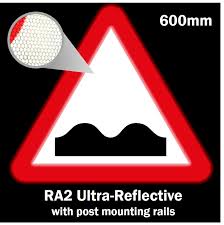Enhancing Road Safety: The Importance of Road Hump Signage

Road Hump Signage: Ensuring Safety on the Roads
When it comes to road safety measures, road humps play a crucial role in controlling vehicle speed and improving safety for both drivers and pedestrians. However, the effectiveness of road humps can be significantly enhanced with proper signage.
The Importance of Road Hump Signage
Road hump signage serves as a visual warning to drivers that they are approaching a raised platform on the road. This advance warning gives drivers time to reduce their speed and navigate the road hump safely. Without proper signage, drivers may not be aware of the presence of road humps, leading to abrupt braking or potential accidents.
Types of Road Hump Signage
There are several types of road hump signage that are commonly used:
- Warning Signs: These signs typically feature an image of a road hump along with a speed limit reminder to alert drivers in advance.
- Road Markings: Painted markings on the road surface before and after the road hump serve as a visual indicator to drivers.
- Reflective Studs: Reflective studs placed along the edges of the road hump provide additional visibility, especially during nighttime or adverse weather conditions.
- Flashing Lights: In some cases, flashing lights may be installed near road humps to further grab driver attention.
The Role of Road Hump Signage in Preventing Accidents
Properly designed and strategically placed road hump signage can help prevent accidents by ensuring that drivers are aware of upcoming traffic calming measures. By giving clear and timely warnings, road hump signage contributes to reducing speeding and improving overall road safety.
In Conclusion
Road humps are effective traffic calming tools, but their impact is maximised when accompanied by appropriate signage. By investing in clear and visible road hump signage, authorities can enhance safety on roads, reduce accidents, and create a more secure environment for all road users.
Understanding Road Hump Signage: Purpose, Safety Benefits, Types, Placement, and Regulations
- What is the purpose of road hump signage?
- How does road hump signage improve road safety?
- What types of road hump signage are commonly used?
- Where should road hump signage be placed for maximum effectiveness?
- Do road hump signs have specific regulations or standards that need to be followed?
What is the purpose of road hump signage?
The purpose of road hump signage is to provide advance warning to drivers about the presence of raised platforms on the road, known as road humps. By alerting drivers through visual cues such as warning signs, road markings, reflective studs, or flashing lights, road hump signage aims to encourage drivers to reduce their speed and navigate the road humps safely. This proactive approach helps prevent accidents, promote smoother traffic flow, and ultimately enhance overall road safety for both drivers and pedestrians.
How does road hump signage improve road safety?
Road hump signage plays a vital role in enhancing road safety by providing clear visual warnings to drivers about the presence of road humps ahead. By alerting drivers in advance, road hump signage prompts them to reduce their speed, thereby preventing abrupt braking and potential collisions. The visibility of road hump signage also helps drivers navigate the raised platforms safely, reducing the risk of accidents caused by sudden surprises on the road. Ultimately, road hump signage contributes to creating a safer driving environment by promoting adherence to speed limits and improving overall awareness of traffic calming measures.
What types of road hump signage are commonly used?
One frequently asked question regarding road hump signage is about the types commonly used. There are several common types of road hump signage that serve to alert drivers of upcoming raised platforms on the road. These include warning signs featuring an image of a road hump along with speed limit reminders, road markings painted on the road surface before and after the hump, reflective studs placed along the edges for enhanced visibility, and in some cases, flashing lights to further draw driver attention. Each type of signage plays a crucial role in ensuring that drivers are informed well in advance of approaching road humps, promoting safer driving practices and reducing the risk of accidents.
Where should road hump signage be placed for maximum effectiveness?
To ensure maximum effectiveness, road hump signage should be strategically placed in advance of the road hump to provide drivers with sufficient warning. Ideally, road hump signage should be positioned at a distance that allows drivers to adjust their speed safely before reaching the hump. Placing signage too close to the road hump may not give drivers adequate time to react, while placing it too far in advance may lead to confusion. Additionally, road hump signage should be clearly visible and unobstructed by vegetation or other objects to ensure that drivers can easily spot and respond to the warning. By placing road hump signage thoughtfully and visibly, authorities can enhance its effectiveness in improving road safety and reducing accidents.
Do road hump signs have specific regulations or standards that need to be followed?
Road hump signs are subject to specific regulations and standards that must be followed to ensure consistency and effectiveness in road safety measures. In the UK, road hump signage is governed by guidelines set out in the Traffic Signs Regulations and General Directions (TSRGD). These regulations outline the design, placement, and visibility requirements for road hump signs to provide clear and uniform warnings to drivers. By adhering to these standards, authorities can enhance the visibility of road humps, promote driver awareness, and ultimately contribute to a safer road environment for all users.
